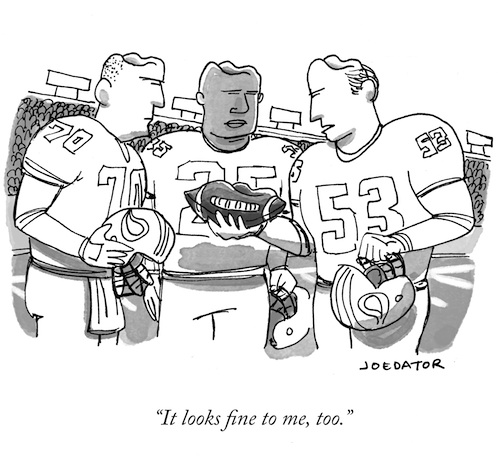Who sounds like a deflategate liar: Robert Kraft or the NFL’s lawyers?
 Two people are arguing in print. Who do you believe? The one who writes more clearly, not necessarily the one that’s right.
Two people are arguing in print. Who do you believe? The one who writes more clearly, not necessarily the one that’s right.
Which brings us to deflategate.
When the Patriots played the Colts in this year’s AFC championship game, officials found some of the balls to be underinflated. The NFL just finished investigating whether the Patriots intentionally let air out of the footballs because their quarterback Tom Brady likes them that way.
Here’s what the 243-page “Wells Report” prepared by the NFL’s investigative law firm said (I’ve highlighted the weasel words):
In particular, we have concluded that it is more probable than not that Jim McNally (the Officials Locker Room attendant for the Patriots) and John Jastremski (an equipment assistant for the Patriots) participated in a deliberate effort to release air from Patriots game balls after the balls were examined by the referee. Based on the evidence, it also is our view that it is more probable than not that Tom Brady (the quarterback for the Patriots) was at least generally aware of the inappropriate activities of McNally and Jastremski involving the release of air from Patriots game balls.
Sounds like bullshit to me (and yes, I know those are terms with legal definitions, but they muddy the meaning). Patriots owner Robert Kraft’s response comes off quite differently, with bold statements:
. . . I unconditionally believed that the New England Patriots had done nothing inappropriate in this process or in violation of the NFL rules . . . that sentiment has not changed.
I was convinced that Ted Wells’ investigation would find the same factual evidence supported by both scientific formula and independent research as we did and would ultimately exonerate the Patriots.
Ah, science. Here’s what the scientific experts that the NFL hired, called Exponent, had to say about the science (I’ve highlighted the wimpy scientific passive here):
According to basic thermodynamics, it is completely expected that the temperature and pressure inside a football . . . rise when brought back into a warmer environment. It is important to note, however, that these variations in temperature and pressure are time-dependent . . . This difference in the magnitude of the decrease in average pressure between the Patriots and the Colts footballs, as measured at halftime, was determined to be statistically significant . . . [T]he precise combination of factors required for the Patriots halftime measurements to fall within the range predicted by the transient experiments while also matching the Colts halftime measurements to the predicted range required setting certain parameters—particularly the timing of the halftime testing and the surface condition of the footballs—at levels believed to be unrealistic and unlikely to have been present on Game Day.
Ah, glad we cleared that up.
If you wade through the verbiage in the report, the details are pretty damning. NFL commissioner Roger Goodell has already fumbled several contentious issues in the last year. So to help him out, I’ll rewrite the Wells report in the plain language he needs to win people over:
Short version: The Patriots employees in charge of the footballs before the AFC championship game sure look guilty. They texted each other frequently about proper ball inflation, and one of them took the balls into the bathroom for almost two minutes just before the game. While it’s true that footballs shrink when they cool off, our physics experts say that doesn’t explain what we measured on the field. While I can’t prove that Tom Brady put them up to it, it’s pretty clear that underinflating footballs was part of game prep for New England. They cheated. And they’re going to have to pay.
Cartoon licensed from New Yorker cartoonbank.com.
What this means is that the evidence pointed to cheating, but there was no smoking gun such as a video. If this were college football, the Pats would be forfeiting their title. All they will get is a slap on the wrist.
When I saw the language from the report, I knew this would be perfect fodder for your blog. Nice take on this.
This does present a challenge for a study author – all of their evidence is circumstantial. The texts between the ball crew is very damning but not concrete proof (could be locker room style smack talk between guys). There is no direct evidence here. Even your short version has some mustelid words in it – “sure look guilty” and “pretty clear”.
When all you have is very strong circumstantial evidence that any reasonable person would conclude guilt shouldn’t the author clearly say that upfront and then the following statements do not need caveats like “probably”?